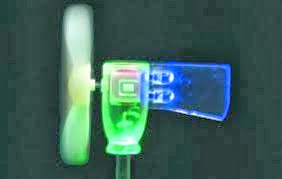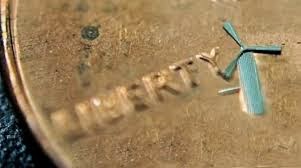 Researchers have developed tiny
‘micro-windmills’ and claimed they can potentially revive the dead batteries of
your phone in just a few minutes.The 1.8mm-wide windmills look fragile, but
UTA(University of Texas Arlington) researchers said that their flexible nickel
alloy components can stand up to strong winds without undergoing any
fracture.
Researchers have developed tiny
‘micro-windmills’ and claimed they can potentially revive the dead batteries of
your phone in just a few minutes.The 1.8mm-wide windmills look fragile, but
UTA(University of Texas Arlington) researchers said that their flexible nickel
alloy components can stand up to strong winds without undergoing any
fracture.While commercial wind turbines have been trending toward larger sizes, from 300 kW capacity in 1990 to 7.5 MW in 2011, sometimes it is worth bucking the trend. Professor J.C. Chiao and his postdoc Dr. Smitha Rao of the University of Texas at Arlington have taken this contrarian philosophy to the extreme. They have developed a MEMS-based nickel alloy windmill so small that 10 could be mounted on a single grain of rice. Aimed at very-small-scale energy harvesting applications, these windmills could recharge batteries for smartphones, and directly power ultra-low-power electronic devices.
These inventions are essential to build micro-robots that can be used as surgical tools, sensing machines to explore disaster zones or manufacturing tools to assemble micro-machines,” UTA says.
One of the Indian researchers named Smitha Rao along with other foreign researchers said “Flat panels with thousands of windmills could be made and mounted on the walls of houses or building to harvest energy for lighting, security or environmental sensing and wireless communication.”
Smitha Rao and J.-C. Chiao designed and built the device that is about 1.8 mm at its widest point. A single grain of rice could hold about 10 of these tiny windmills. Hundreds of the windmills could be embedded in a sleeve for a cell phone. Wind, created by waving the cell phone in air or holding it up to an open window on a windy day, would generate the electricity that could be collected by the cell phone’s battery.
The micro-windmills (technically called horizontal axis wind turbines) have a three-bladed rotor 1.8 mm in diameter mounted on a tower about 2 mm tall. The mount is a friction hub, but this probably becomes an air bearing when the rotor is spinning. The thickness of the windmills is about 100 microns.
 At this point, the capacitor
is discharged into a storage supercapacitor or battery, and the generator is
ready for the next cycle. With a coating of a high-k dielectric on the tower,
perhaps 10 microwatts of electric power will be generated by a single windmill,
depending on wind velocity. Note that my estimate is based on a crude model;
better designs will increase the conversion efficiency considerably.
At this point, the capacitor
is discharged into a storage supercapacitor or battery, and the generator is
ready for the next cycle. With a coating of a high-k dielectric on the tower,
perhaps 10 microwatts of electric power will be generated by a single windmill,
depending on wind velocity. Note that my estimate is based on a crude model;
better designs will increase the conversion efficiency considerably.In addition to the unusual development of the micro-windmill, Chiao's lab has produced a range of MEMS devices and components that should help the development of medical micro-robotics. UT-Arlington has entered into a collaborative agreement with WinMEMS Technology of Taiwan for commercial development of these MEMS innovations.
“The company was quite surprised with the micro-windmill idea when we showed the demo video of working devices,” Rao said. “It was something completely out of the blue for them and their investors.” For us as well.
0 comments:
Post a Comment